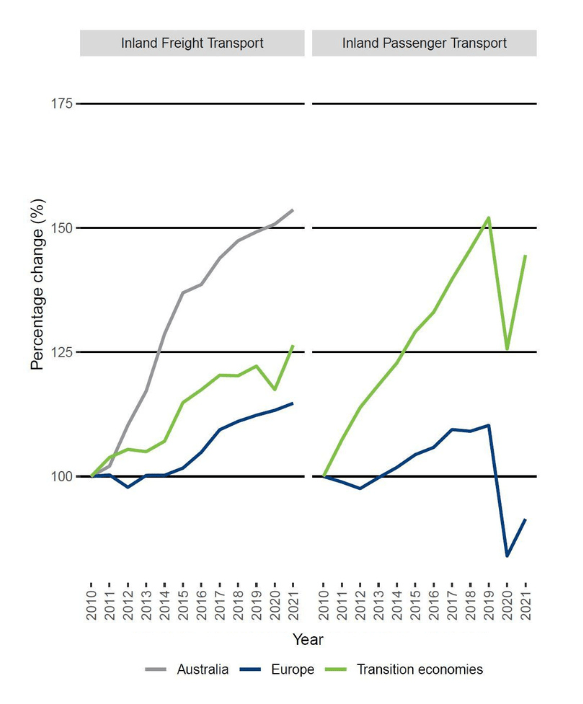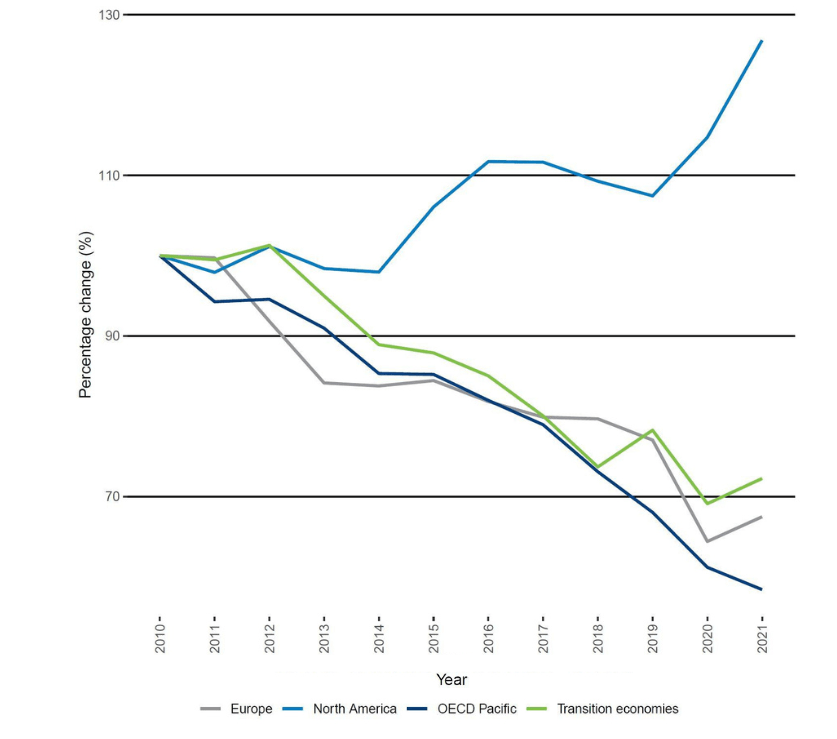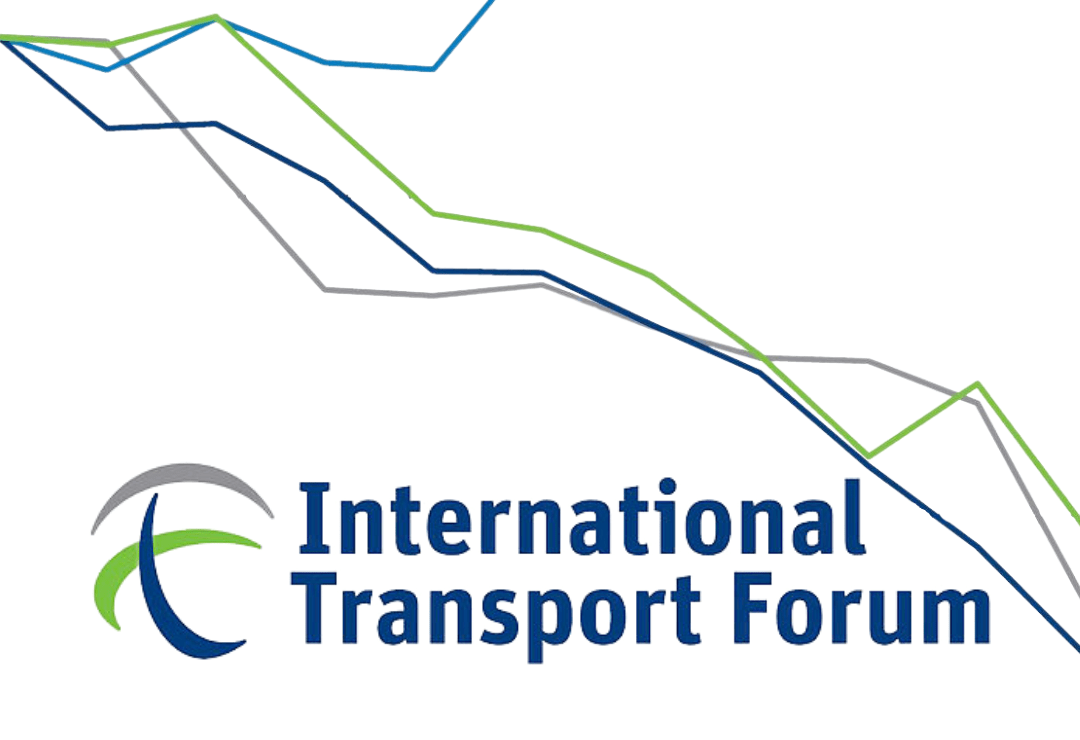Modal shift to cleaner transport fails to materialise, shows ITF's brief
Car numbers increase, freight does not shift to sustainable modes fast enough, and rail struggles to recover from COVID-19 — these, and many other points, are featured in the latest statistics brief from the International Transport Forum (ITF).
In this brief, global transport data from 2010 to 2021 collected by the International Transport Forum (ITF) shows that:
- Passenger and freight transport demand steadily increased from 2010 until early 2020 following the outbreak of COVID-19;
- Economic growth is one of the most significant drivers of transport demand between 2010 and 2021;
- Inland freight transport does not show a shift to more sustainable modes;
- Sea transport accounts for the largest share of containerised freight;
- The pandemic heavily affected rail passenger transport in Europe, which dropped 51% between 2019 and 2021;
- Road passenger transport was less impacted by the pandemic than rail;
- The share of passenger transport by car increased for all reporting countries between 2010 and 2021.
The data presented in the statistics brief are from the ITF survey 'Trends in the Transport Sector', which included variables on freight transport, passenger transport, and road safety. The survey was completed by ITF member countries, processed by ITF statisticians, and published each year on 31 October.
What is relevant for us?
Growing transport demand from 2010 up until the pandemic

Figure 1. Transport demand growth by sector and region — Credit: ITF
Over the previous decade, inland freight transport demand in Europe has steadily grown. In comparison to 2010, inland freight transport increased by 15% in 2021, with the arrival of COVID-19 having little effect on inland freight travel in the region — indeed, between 2019 and 2021, inland freight transit increased by 2% in Europe.
On the other hand, after one decade of constant growth, inland passenger transport in Europe was significantly impacted in 2020. The COVID-19 pandemic severely disrupted the European passenger transport sector, reducing passenger travel demand to below 2010 levels. Data for 2021 showed that inland passenger transport was 9% lower in Europe compared to 2010.
Road crash fatalities decrease despite growth in transport
Deaths from road crashes fell in Europe between 2010 and 2021. The COVID-19 pandemic accentuated the drop in road fatalities due to travel restrictions imposed in many countries, resulting in fatalities falling by 33% in 2021 in the area compared with 2010.

Figure 2. Road crash fatalities: trends by region — Credit: ITF
Economic and transport growth and road crash fatalities move in tandem when no specific road safety measures are taken. Research by the ITF's International Traffic Safety Data and Analysis Group (IRTAD) also confirms this relationship, concluding that severe economic downturns are invariably followed by a marked drop in road crash fatalities.
Freight shift to road without carbon-reducing measures jeopardises climate goals
A few European countries increased their use of rail to transport freight shifting from road transport — most notably Slovenia (+7%) and Italy (+5%). Other countries with an increased share of rail freight are Finland, France, Germany, and Hungary.
However, most countries that experienced an inland freight modal shift showed an increase in the use of road transport. Serbia (+40%), Lithuania (+21%), and Moldova (+13%) are the top three countries with the highest shift towards road transport, reducing their shares of rail and inland waterways use. The remaining countries have also increased the use of trucks on average by 4%.
The increasing use of road transport over railways in most countries translates into more carbon dioxide (CO2) emissions, hindering global climate efforts. ITF’s Transport Climate Action Directory shows that improving vehicle fuel efficiency and adopting new, zero-emission vehicle technologies can be the first steps in reducing emissions from the freight transport sector. Promoting mode shift from road to rail is also an effective policy since the emissions intensity of rail freight is nearly ten times lower than that of trucks.
Road passenger transport proves more resilient than rail during pandemic
Until 2019, road transport by passenger car, buses, and coaches increased in Europe, with the only two countries showing a contraction of road transport between 2010 and 2019 being Sweden (-10%) and Spain (-4%).
Changes between 2019 and 2021 showed that most countries experienced a contraction smaller than 10% due to COVID-19, with Italy (-29%), Croatia (-13%), and France (-11%) being the three most affected economies among the reporting countries. Compared to 2010, most countries have returned to the level at par or above par, except for Italy (-25%), Sweden (-16%), and Finland (-11%).
Increasing share of car use for all countries
The pandemic has had a lesser impact on road passenger transport. Private vehicles could indeed provide more personalised mobility options when social distancing requirements were in place, while buses, coaches, and rail became less attractive (or, at times, less frequent) due to social distancing measures.
However, while these modes were heavily disrupted, with Poland (+10%) and Hungary (+10%) showing the most significant car share increases, it is important to highlight that the modal shift towards private vehicles should not be glorified, as it will inevitably increase CO2 emissions unless reversed, and that more sustainable options, such as buses, coaches, and rail, could and should be favourable alternatives for inland freight and passenger transport when this cannot be covered by active modes.
